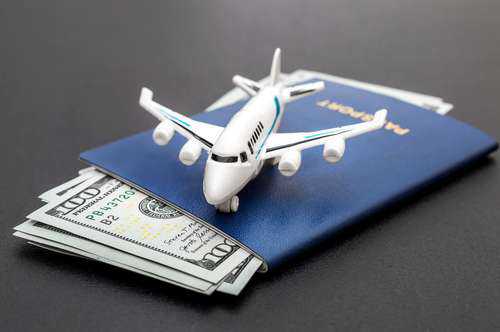Traveling can broaden the mind and enrich life in many ways. Unfortunately, it can sometimes also become necessary in short order due to unforeseen life events, or emergencies can even occur while traveling. If you are searching for emergency travel loans or other immediate financial help for pressing travel situations, the type of available resources depend on your circumstances.
- Currently traveling: If you are currently traveling abroad and facing an emergency that requires financial resources, the United States Department of State has compiled a helpful guide that can assist US citizens traveling abroad.
- Having to book travel: If you are not yet on the road but need to book a trip at short notice due to an urgent life event or unforeseen situation, emergency travel loans could help when you need fast funding for travel expenses.

Call Our Team
Take the first step and call our toll-free hotline to speak with a specialist.
Understanding Emergency Travel Financing
Having to hit the road or flying somewhere on short notice can put a significant strain on finances. With average plane tickets at around $400, and an average night at a hotel close to $150, an urgent trip can easily exceed a rainy day fund. Besides the ever-increasing cost of traveling, having to book things last minute can increase the cost, due to lower supply and less time to shop around.
If an unexpected situation like a family emergency or medical issue requires a quick trip that exceeds your current budget, emergency financing like travel loans may be a helpful tool allowing you to book the trip you need without having to pay everything out of pocket up front.
The main differences between emergency travel loans and other loans are the purpose of the loan, the speed at which they can be obtained, and the eligibility and funding sources for some of them.
- Loan purpose: As the name suggests, these loans are primarily intended for booking travel, and the associated costs of travel, food, and lodging.
- Speed: Unlike other loan options, emergency travel loans are designed food speed. Companies that provide urgent travel financing have designed processes that allow them to provide loan funds as fast as same-day.
- Eligibility and funding sources: some emergency travel lenders offer loans only to specific type of borrowers. The most prominent examples of loans that are only available to certain borrowers include emergency financing through the Navy Marine Corps Relief Society, Cost Guard Mutual Assistance, or financial assistance for military families from the Red Cross. As the name of these lenders and programs implies, these financing options are only available to the respective government employees or their family members.
How to Get an Emergency Travel Loan
To get an emergency travel loan, following the below steps can help you have a positive loan experience despite the pressing situation.
Assess your needs: As a first step, try to get an idea of the exact needs for your travel loan. What loan amount are you looking for, and what would a payment schedule look like that you can realistically afford?
Research available loan options: Having a good idea of your needs can allow you to zero in on available loan options that align with your needs. For example, if you need a large loan, lenders that have a low maximum loan amount may not work for you. Also, as mentioned above, if there are special lending programs available to you based on your profession, it’s a good idea to research those as they can come with very favorable loan terms such as interest-free loans or loans with very low interest rates.
Gather documents: Your travel loan may come with specific document requirements, which usually have to do with proving your identity, residence, and income. For any loans based on your profession, you may also need to provide proof that you are in-fact a member of that profession (e.g. you may need to provide your Coast Guard ID). Some providers of travel loans may also require bills or estimates of your travel costs.
Apply and get funded: Once you’ve zoomed in on the best credit option for your urgent travels it’s time to apply. Many fast travel loans are available through an online application, which is convenient especially when time is of the essence! Upon approval, you can expect to be asked to submit the required documents before receiving a loan agreement for signature. Once you’ve signed the loan agreement, emergency travel funds can be available in no time!
Can You Use a Car Title Loan for Emergency Travel Expenses?
Yes! Auto title loans serviced by LoanMart can be used to finance an urgent trip. While title loans are not specifically designed with emergency travel in mind, they can potentially help borrowers who did not qualify for other types of travel funding. Especially borrowers who are looking for emergency travel loans with bad credit may be able to obtain funds even though other lenders were not able to help them.
With auto title loans serviced by LoanMart, borrowers looking for emergency travel cash can expect the following benefits:
- Quick access to funds for urgent travel needs: Upon approval, car title loans can be available as fast as same-day.
- Flexible repayment options: With manageable monthly payments and loan terms that are longer than payday loans and some personal loans, car title loans can offer the flexibility that borrowers need.
- Loan amounts: Loans amounts for car title loan can be larger than the amounts available through unsecured options.
Final Thoughts About Emergency Travel Loans
Emergency travel loans can help borrowers book unexpected travel that exceeds their budget. Before applying for a loan, potentially borrowers should have a good understanding of their needs, available travel loan options, and potential eligibility and document requirements.
Auto title loans serviced by LoanMart can be used as emergency travel loans with bad credit as they can offer fast funding with flexible repayment terms.
Frequently Asked Questions:
What to do if your loan application is denied?
If your application for an emergency travel loan has been declined, see if the lender can provide more information about the reason for denial. Depending on the reason, you may be able to address it and apply again.
How to use emergency travel loan funds effectively?
You can take advantage of some of the following strategies in order to make smart use of your emergency travel funds:
- Prioritize expenses: Book only what’s essential, and avoid expensive upgrades like premium seats or premium boarding privileges. Consider using public transportation over booking a cab or an Uber.
- Shop around: even though you are booking a trip without much time, spending a few minutes shopping around can potentially save you a lot of money. Comparison platforms like Google Flights can help you find the cheapest way to get you where you need to go.
- Stay focused: Spend your emergency loan funds strictly on the trip that you need to book. Don’t divert funds to other optional expenses. If your travel loan amounts ends up exceeding what you needed, consider using the extra funds to pay back your travel loan early.
What happens if you cannot repay the loan on time?
If you cannot repay a travel loan on-time, the potential consequences depend on what type of loan you’ve obtained. If the loan provider reports the payment history to the credit bureaus, not paying your travel loan can impact your credit score. If the loan is secured by collateral, you may risk having the collateral seized by the lender or loan servicer.

